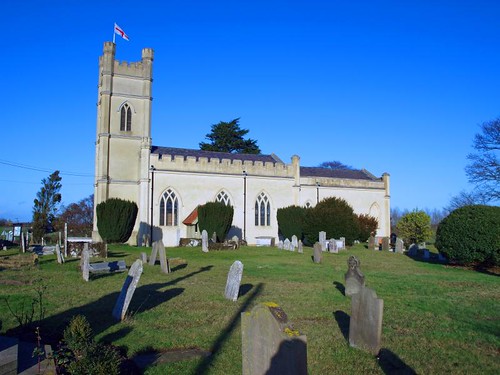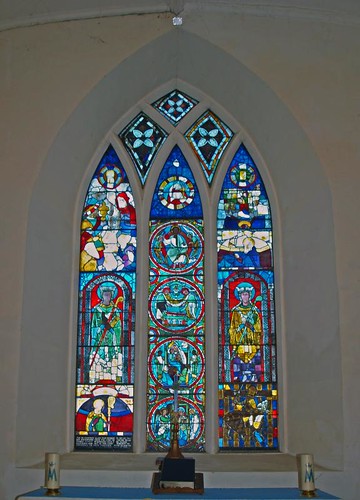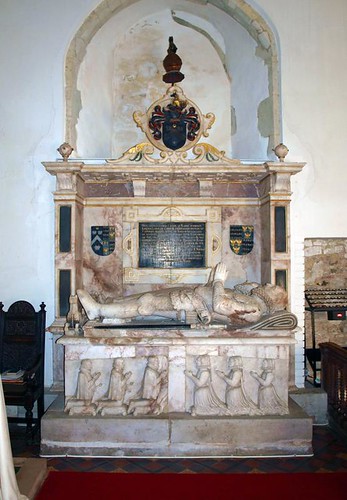The church, which has been extensively damaged over the years by repeated restorations, still contains three remarkable icons: the east window, the Wiseman monument and a Majolica rondel in the style of a Della Robbia rondel.
The East window is the glory of this church, although many other features play second fiddle, especially the Wiseman tomb and a good selection of hatchments. Four central rondels are French and date from circa 1180; in 1840 Rev Bradford Hawkins bought the glass from Chenu Church and had the East window created. The oldest glass is surrounded with later glass from the C12th, C13th and C16th. Chenu's loss means that Rivenhall now contains the oldest stained glass known in Europe.
Whilst acknowledging that St Mary has been restored to within an inch of its life, has had a new tower tacked on and is nowhere near original I must say that I loved it; plain and simple maybe but also light and airy and full of interest.
ST MARY AND ALL SAINTS. 1838-9. Brick, with the use original walls. Narrow, tall W tower with polygonal buttress and battlements. The nave has the same feature at the angles. Intersected window tracery as was popular in the early C19. Plain white interior with coved ceiling with thin narrow transverse ribs. - COMMUNION RAILS. With twisted balusters, 1700. - STAINED GLASS. The best in the county; assembled in the E window. Two large frontal figures of the C12 (from St Martin at La Chenu N of Tours). - Four roundels of c. 1200; of exceedingly good quality and of unknown but no doubt also French origin. - Horseman with helm, inscribed ‘Robert Lemaire’. - Demi-figure of a Bishop c. 1500. - Two HELMS of the late C16 and the C17. - MONUMENTS. Raphe Wyseman d. 1608 and wife. Standing wall monument of alabaster and marble, with tomb-chest, recumbent effigies on a rolled-up mat; the children kneel in the ‘predella’. - Thomas Western d. 1699, good monument with segmental pediment, scrolls, flowers, and cherubs’ heads. - William Western d. 1729. Big black sarcophagus in front of a big black obelisk; no effigies - Baron Western of Rivenhall d. 1844. By Clark of Wigmore Street. In the Gothic taste.
The church has been rebuilt but has kept some of its old possessions, and they still read here from a Bible of 1717. There are two coffin lids 700 years old, twisted altar rails of the 17th century, and a magnificent tomb of alabaster and marble, on which lie Ralph Wyseman of 1608 and his wife Elizabeth, a grand-daughter of the infamous Lord Rich. Ralph wears armour and a ruff, and rests his feet on a seahorse, a quaint creature seen again on a helmet hanging above. Elizabeth is wearing a beautiful headdress; and in front of the tomb kneel three sons and three daughters.
A memorial tells of Samuel Western, who died in 1699; and on the floor, copied exactly from the marbles of its day, is a gravestone of cast-iron, with the family arms. It belongs to Thomas Western of Queen Anne’s time, who married a daughter of a London ironmonger. The memory of a more famous member of the family is kept green by an elaborate Gothic monument with two female figures. It is to Lord Western, who died in 1844, having bought Felix Hall at Kelvedon and filled it with treasures collected on his travels. For 42 years he worked in Parliament in the interests of agriculture, and did much to improve our breeds of sheep. He was also a keen worker for prison reform.
Tudor Hall by the church has a chimneystack of the 17th century; and Rivenhall Place, in a park of 100 acres is partly Tudor too. From the remains of a far older house here Roman pottery and coins have been found; and when the foundations were excavated a corridor with concrete walls 18 inches thick was traced for nearly a quarter of a mile.
At Rivenhall was born Thomas Tusser, a famous small poet of Shakespeare’s day whose work was produced in our day in a volume issued at five guineas. He is unique. His long poem on Five Hundred Points of Good Husbandrie, beloved of generations of literary men on the one hand and the practical guide of centuries of reading farmers on the other, is an incomparable picture of agricultural life, a thoroughly competent and exhaustive account of farming, stock-breeding, and husbandry in all its parts, with the tasks for each season and servant, the management of great farms and small, of dairy and household, of men, implements, and animals. Yet Tusser was a failure as a farmer. All the wisdom, pathos, and humour of his Points are born of his own experience, and sad that experience was. He claims good lineage and gentle blood, but was sent by a pitiless father at an early age to serve as a chorister at the chapel of Wallingford Castle, Berkshire, where he was ill-clad and ill-used. It was in the days of the press-gang for choristers, when licensed officers would abduct children for the royal choirs, and Tusser was hustled from place to place where he was wanted. Eventually he reached St Paul’s, and from there went to Eton, where the notorious Nicholas Udall was headmaster,
Where fifty-three stripes given to me
At once I had
For fault but small, or none at all,
It came to pass, thus beat I was;
See, Udall, see, the mercie of thee
To me, Poor lad.
Many more stripes of Fate were to fall on poor Thomas, yet he had happy days at Cambridge and for ten years with a lord, whom he served as a musician before the plough became his music, as he used to say.
Twice married, he farmed in Suffolk and Norfolk, but in spite of his comprehensive knowledge he was a failure on the land, though one of its best poets. His poem at first comprised only a hundred points, to which were added as many Poyntes of Huswifery; and from this nucleus sprang the complete work. One of his best compositions is his Ladder of Thrift, in which occur these familiar couplets:
To take thy calling thankfully
And shun the path to beggary;
To grudge in youth no drudgery
To come by knowledge perfectly;
To pray to God continually
For aid against thine enemy....
None of his own business ventures flourished, and this poor country loving poet was eventually thrown into prison for debt. He showed others the way to succeed but could not succeed himself, and died in a London prison in 1580.
Flickr.



No comments:
Post a Comment